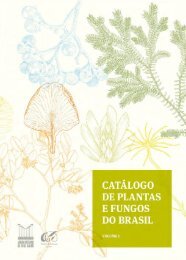A TAXONOMIC REVISION OF HYMENOPHYLLACEAE
A TAXONOMIC REVISION OF HYMENOPHYLLACEAE
A TAXONOMIC REVISION OF HYMENOPHYLLACEAE
Create successful ePaper yourself
Turn your PDF publications into a flip-book with our unique Google optimized e-Paper software.
A. Ebihara et al.: A taxonomic revision of Hymenophyllaceae<br />
Distribution — Southern Chile, New Zealand and New Caledonia; at least 8 species<br />
are known.<br />
Habitat — Epiphytic on tree trunks, occasionally terrestrial.<br />
Chromosome base number — x = 36.<br />
Note — This subgenus corresponds to the ‘H. sanguinolentum clade’ in Hennequin<br />
et al. (in press), and is characterized by brown multicellular hairs on the stipes or blade<br />
margins, or alternatively by dentate blade margins. In exceptional cases, H. sanguinolentum<br />
has nearly glabrous fronds, almost indistinguishable from H. polyanthos – but<br />
containing of oils that make an impression of the blades on the mounting paper; this<br />
feature is a characteristic of this group.<br />
RepResentative species:<br />
Hymenophyllum krauseanum Phil.; H. magellanicum (Desv.) Willd.; H. paninese Ebihara &<br />
K. Iwats.; H. plicatum Kaulf.; H. sanguinolentum (G. Forst.) Sw.; H. scabrum A. Rich.; H. tortuosum<br />
Hook. & Grev.; H. villosum Colenso.<br />
7. Subgenus Hymenoglossum (C. Presl) R.M. Tryon & A.F. Tryon<br />
Hymenophyllum Sm. subg. Hymenoglossum (C. Presl) R.M. Tryon & A.F. Tryon (1981) 134.<br />
— Hymenoglossum C. Presl (1843) 35. — Hymenophyllum Sm. sect. Hymenoglossum (C. Presl)<br />
T. Moore (1857) cxii. — Type: Hymenoglossum cruentum (Cav.) C. Presl (= Hymenophyllum<br />
cruentum Cav.).<br />
Hymenophyllum Sm. sect. Integra C. Presl (1843) 32. — Lectotype: Hymenophyllum asplenioides<br />
Sw. (selected by Morton (1968) 172).<br />
Rhizomes long-creeping, filiform, nearly glabrous. Stipes 7–15 cm long. Blades simple<br />
to pinnatifid, ovate to narrowly ovate, 15 by 4 cm, margins of segments entire. Sori at<br />
the frond margins, slightly immersed in the laminae, lips bivalvate, entire, receptacles<br />
included in involucres.<br />
Distribution — Central to South America and Madagascar; 3 species known.<br />
Habitat — Epiphytic on tree trunks.<br />
Chromosome base number — x = 36?<br />
Note — Hennequin et al. (in press) revealed that H. heimii of Madagascar proba-<br />
bly has a sister relationship to H. cruentum of southern Chile (formerly treated as a<br />
monotypic genus, Hymenoglossum). A Central-South American species, H. asplenioides,<br />
is also placed here because of its morphological resemblance to the two species<br />
above.<br />
RepResentative species:<br />
Hymenophyllum asplenioides Sw.; H. cruentum Cav.; H. heimii Tardieu.<br />
8. Subgenus Fuciformia Ebihara & K. Iwats., subg. nov.<br />
A subgenere Globosa rhizomatibus brevibus et erectis differt.<br />
Based on Hymenophyllum Sm. sect. Fuciformia H. Christ (1897) 20, nom. nud. — Type: Hymenophyllum<br />
fuciforme Sw.<br />
Rhizomes erect or short-creeping, thick, densely covered with reddish hairs. Stipes 3–15<br />
cm long. Blades tri- to quadripinnate, ovate to narrowly ovate, 65 by 15 cm, margins<br />
of segments entire. Sori at the tips of ultimate segments, lips bivalvate, entire or wavy,<br />
receptacles included or slightly extruded from involucres.<br />
13







